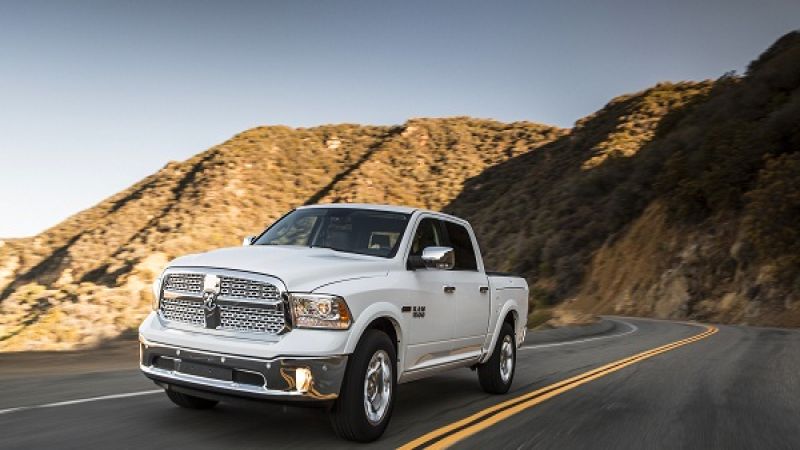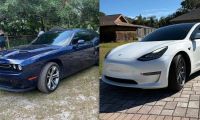But setting those two issues aside, is it really even a good idea? Should automakers plan to buy emissions credits from each other to meet federal requirements? Find out below.
In the report, automakers by and large were improving their Corporate Average Fuel Economy numbers. Companies like Chrysler, Ferrari and Daimler – that may have trouble meeting future targets - bought large sums of credits. These companies added thousands of these credits to their stockpiles to use in future years.
What Are Emissions Credits?
The EPA sets strict rules regarding an automakers "Corporate Average Fuel Economy," frequently referred to as CAFE. These rules regulate exactly how fuel efficient an automaker's product line-up should be. If an automaker produces a "fleet" of vehicles that are more fuel efficient than required, the automaker receives "credits." If an automaker produces a fleet of vehicles that are less efficient than required, they must either find some credits somewhere or pay a hefty fine.
When it comes to calculating an automaker's fleet fuel economy rating, there are a few things to know:
1. The fleet rating is sales weighted - if an automaker sells 10k hybrids and 90k non-hybrids, than their fuel economy rating is adjusted to be 10% of the hybrid's rating and 90% of the non-hybrid's rating (or thereabouts... the math is actually a little more complex).
2. Each vehicle's size (larger vehicles can burn more fuel) and designation (trucks can burn more fuel than cars) effects the fleet fuel economy requirements. An automaker that builds a lot of large trucks will have a lower requirement than an automaker that specializes in small passenger cars.
3. Automakers who adopt new technology - like start-stop systems that save gas at stoplights, electric powertrains, fuel cells, etc. - essentially get extra credit above and beyond the fuel economy benefits these technologies provide.
The big picture here is that the federal government is trying to force automakers to build more advanced, more fuel-efficient vehicles. But the important take-away for this article: Automakers who build fuel-efficient vehicles have credits they can sell to their competitors.
Why Are Credits Important?
For some companies, these new fuel economy standards are not that big of a deal. Honda and Toyota, for example, already exceed the federal fuel economy requirement. These shouldn't have too much trouble hitting their marks in the future either, as Toyota has plans to produce a fleet of zero emissions fuel cell vehicles, more hybrids, etc. Same with Honda.
But for a company like Fiat-Chrysler, which mostly sells Ram trucks, Jeep SUVs, mini-vans, and muscle cars (at least in the US), these new standards are tough. First of all, Fiat-Chrysler doesn't have a large fleet of popular economy cars (aka Honda Civic and Toyota Corolla) they can use to offset some of their popular gas-guzzlers. Secondly, Fiat-Chrysler doesn't really have much to write home about in terms of hybrids, electric cars, fuel cells, etc.
Thus, Fiat-Chrylser has to choose between three options:
1. Make their fleet more fuel efficient
2. Pay federal fines for failing to meet requirements
3. Buy credits from other automakers
For a lot of reasons big and small, Fiat-Chrysler (and a lot of other automakers) are choosing the third option, buying and selling credits like kids swap baseball cards.
Buyers and Sellers
According to the EPA report, Tesla transferred 227,713 credits from 2010 to 2012 models to Daimler. Daimler owns a stake in Tesla and owns Mercedes-Benz among others. Daimler also bought 250,000 credits for the 2012 model year sales from Nissan. Ferrari bought 90,000 credits from Honda from 2010 model year sales. Chrysler bought 500,000 credits from 2011 model year sales from Nissan. etc.
While Nissan was a big seller, it turns out that they don’t have the most credits...that particular honor belongs to Toyota and Honda, who have 60 percent of all credits available. 136.7 million to be exact (combined). While credits can be used by automakers for future production, they expire after 3 years. Honda and Toyota are going to let millions of credits expire this year, and will likely do that again next year.
Are Credits A Long-Term Solution?
Since Honda and Toyota have so many credits, and since credits expire after a few years, it seems possible that companies like Ferrari and Fiat-Chrysler could plan to buy credits from other automakers for the foreseeable future. While this is indeed possible, a plan to buy credits is risky:
- Automakers can apply old credits to their own fleets, which means at some point Toyota, Honda, and others may want to keep their credits for future years.
- There's no guarantee that there will be plenty of credits to go around. If, for example, Honda and Toyota don't exceed the federal fuel economy requirements as easily as expected, the supply of credits could become very small. A tight supply of credits means higher prices.
- Competitors are not required to sell credits. There are competitive reasons for Honda, Toyota, Nissan, Tesla, etc. to keep their credits and force their rivals to both a) pay federal fines and b) suffer from any resulting bad press.
What's more, there's no guarantee that politicians will allow credit exchanges to continue. After all, if the government prohibits the exchange of credits, they'll collect more fines.
Thus, the safest plan is for automakers to improve the efficiency of their vehicles. While buying emissions credits is a reasonable solution in the short term, there's no guarantee credits will be plentiful in years to come.
The million dollar question is, how are companies like Fiat-Chrysler and Ferrari going to meet fuel economy requirements without dramatically changing their core products?













Comments
I think the credits work well
Permalink
I think the credits work well in this case, they incetivize the compliant companies while taxing the non-compliant ones all without wasting any tax payer money. As for meeting the requirements, didn't Ferrari say they plan on making hybrids? And fiat is expanding sales of their 500. Though aren't Fiat and Ferrari technically same company?
Corporate con game. end of
Permalink
Corporate con game. end of report.